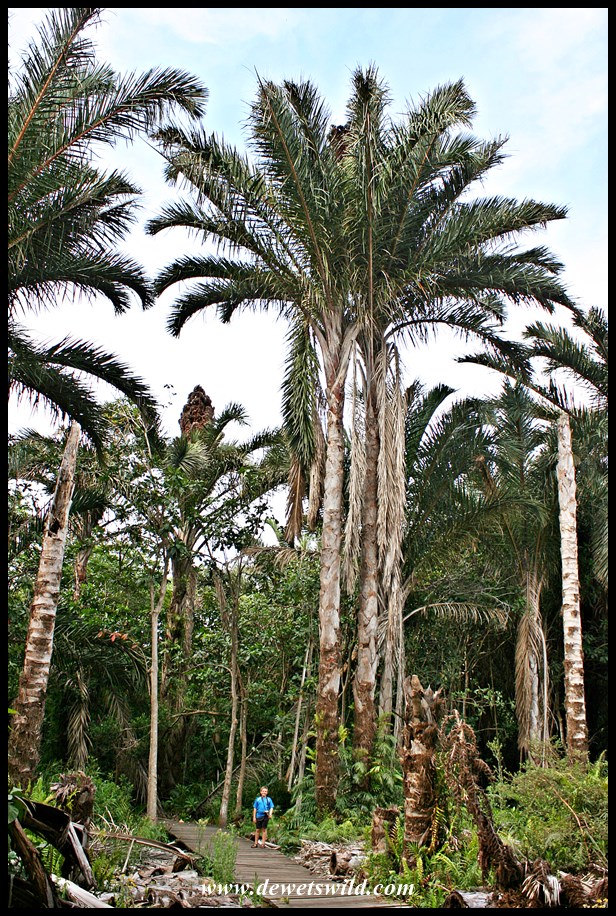Raphia australis
The Kosi Raphia Palm is an enormous tree, growing up to 25m tall with leaves up to 18m long – among the largest leaves of any plant on earth. They grow in swamp forests, often forming dense stands. Around the age of 20-30 years the Kosi Palm flowers only once , producing an immense 3m high brown inflorescence at the top of the plant and then, after bearing thousands of fruit that takes two years to mature, dies. The Raphia Palm family is a main food source for the Palmnut Vulture. Humans use the leaves as thatching material and the petioles to construct huts and fences.
The Kosi Raphia Palm has an extremely limited distribution, occurring only in a few locations in southern Mozambique and around Kosi Bay in the extreme north-eastern corner of Kwazulu-Natal Province in South Africa. The total population of mature individuals number probably around 7,000 only, with the IUCN listing the species as vulnerable, and noting a continuous decline in their numbers due to habitat loss. In 1916 a grove of Kosi Palms were established in the town of Mtunzini, some distance south of their natural range, by the local magistrate. After becoming established and multiplying, Mtunzini’s Raphia Palm Forest was declared a National Monument in 1942. (You may want to click on the image below for an easier read)














Dis darem wonderlik dat daardie palmbome daar geplant is. Pragtige foto’s, Dries!
LikeLiked by 1 person
Die palm-plantasie, en die witaasvoels, is n groot aanwins vir Mtunzini uit n toerisme oogpunt – dit help die plaaslike mense besef hoe ons elke dag se brood-en-botter van n gesonde omgewing afhang!
LikeLiked by 1 person
Daardie aasvoëls is besonders…lyk nie soos aasvoëls nie!
LikeLiked by 1 person
Magnificent palms, Dries. Very interesting info too.
LikeLiked by 1 person
Thanks, Sylvia!
LikeLiked by 1 person
Interesting post on these amazing trees.
LikeLiked by 1 person
Thanks again, Carol!
LikeLike
The size of those palms is amazing! I had no idea that palms got that tall!
LikeLiked by 1 person
They really are imposing!
LikeLiked by 1 person
It looks like an interesting tree.
My wife has used some palms for making paper but they are very tough and require a lot of cooking to break down the fibers. Even then these palm papers were coarse and very fibrous.
LikeLiked by 1 person
That’s so interesting, Tim – I never even thought that palm throngs could be transformed into paper! I’d dare say though that these Kosi Palms would make much better thatching material than paper – these leaves are enormous and thick!
LikeLike
Yes, it would be difficult. Here is a link to my wife’s Fulbright project on paper making in Taiwan. https://www.janeingramallen.com/residency/Taiwan/expanded_grant/Made_in_Taiwan1.htm
The website is very dated and there maybe some broken links.
LikeLiked by 1 person
Obviously your wife poured her heart and soul into the project the results are amazing!
LikeLike
She did. Thank you for taking the time to look.
LikeLiked by 1 person
A magnificent and mysterious palm. I hope there is an urgency to ensure the survival of the palms, Dries. 7000 remaining seems very few to me.
LikeLike
Thankfully the South African portion of the population is well protected in the iSimangaliso Wetland Park, Tracy, but sadly the same can not be said about the plants on the other side of the border with Mozambique.
LikeLiked by 1 person
Some things just aren’t cute and fluffy enough.
Speaking of cute, I don’t suppose you have any photos of sengis, Dries?
LikeLike
I wish, Tracy! Sengis, or elephant shrews as we know them, are very difficult to see – I can probably count the times I’ve seen one on the fingers of one hand – and I’ve yet to get even one picture of any of the various kinds.
LikeLike
I expected your answer, Dries, but thought there was no harm in asking. I hope that one day you will get lucky.
LikeLiked by 1 person
Thank you!
LikeLike